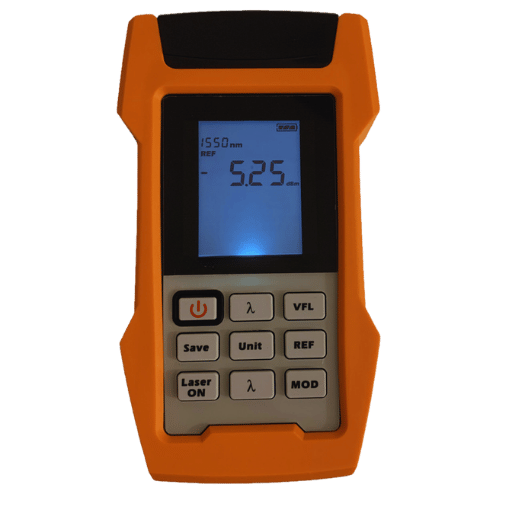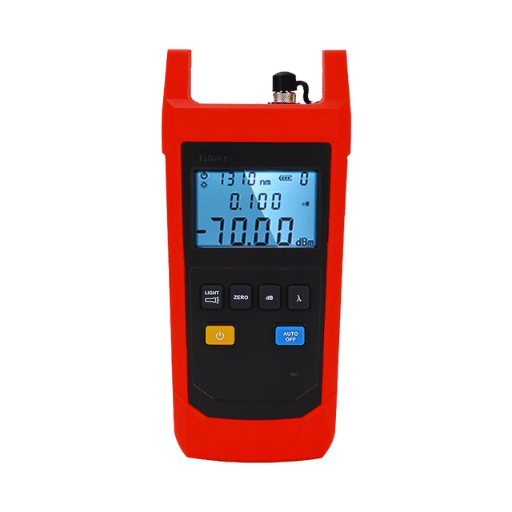This choice is challenging in the ever-evolving context of introducing new devices and technologies. In this case, it is an optical power meter, the incorrect selection of which is likely to impact the efficiency of the entire system. This guide is written to equip readers with the power meter selection know-how necessary for making sound decisions regarding purchasing these devices. The guide identifies models’ primary functional features, explains the most crucial parts of their specifications, and assesses their operational compatibility in detail. Unlocking the countless operational efficiency opportunities throughout your network systems is a topic of utmost relevance.

A fiber optic power meter is a type of testing instrument that measures the level of light power being transmitted through a fiber optic cable. It plays a critical role in testing and diagnosing optical networks, ensuring there are no signal strength problems and determining any difficulties. Its construction usually incorporates a photodetector with a signal processor and a display that outputs the readings in mW or dBm. Power meters are responsible for verifying the signals, thus aiding in fiber communication and system troubleshooting.
Optic power meters measure the optical signal’s power to guarantee its efficiency, particularly in fiber optic networks. It functions by accepting light through a photodetector that converts it to an electrical signal. This signal is then processed to tell the power level. These readings inform whether the optical signal can be sent without risking data loss or degradation in the communication system. Such ease and accuracy render optic power meters vital instruments during a network’s installation, maintenance, or troubleshooting.
A power meter in fiber optics functions by measuring the optical power of a signal traveling through the fiber. The device operates by measuring the light signal with a calibrated photodetector which is then converted to an electrical signal. After this, it undergoes further processing to yield an accurate power measurement that is electronically displayed in dBm. Power meters are used to ensure the signal strength is within the recommended range to guarantee usefulness while reducing the chances of data loss. They are vital instruments for verifying the quality of circuits during the installation, maintenance, and even troubleshooting of fiber optic networks.

These steps guarantee best practice measures are used in an operational environment and bring about efficient and precise measurements of fiber optic power.
Calibration helps ensure the accuracy and consistency of a device’s readings through comparison against a recognized standard. Routine calibration is needed for device aging, changes in the environment, and drift over a period of time. If calibration is not done, precision in measurement is lost, which results in the unreliability of data received. Following the manufacturer’s recommendations and using accredited instruments for calibration is essential to the accuracy of measurements and compliance with established industry regulations.
By avoiding the mistakes listed, one can enhance the accuracy of tests performed, minimize the time taken to troubleshoot problems and guarantee the performance of the fiber network.

Power meters require yearly calibration to ensure accurate performance and effective use. Such timelines irrefutably meet the manufacturers’ expectations, industry standards, and typical wear and tear patterns from regular use. Nevertheless, frequent exposure to extreme environmental conditions, constant usage, or critical measurement needs might require more frequent calibration. Every device has a manufacturer’s guideline, which helps guide specific intervals. Identifying and correcting deviations from measurements is extremely important, and calibration helps ensure accurate power measurements.
Improper calibration may result in severe errors in power measurement, which can cause myopic system functioning and dependency. Calibration, or the lack thereof, whether done incorrectly, will cause measuring devices to generate inaccurate error values. For instance, even with minor drift in calibration, a ±2-3 error is bound to occur in the energy readings, which is greatly significant for precise industrial applications and monitoring power grids. Such inaccuracies can result in inefficient equipment, increase operational costs, and sometimes lead to safety issues.
Recent studies highlight the impact of improper calibration. For example, in advanced manufacturing, incorrect power measurements can halt processes that heavily depend on accurate energy input, such as laser cutting or semiconductor processing. In a similar fashion, solar inverters love improper calibration, which makes them incapable of optimal energy output and minimizes their level of compliance with grid standards. Resolving calibration mistakes guarantees compliance with regulations and operational output.
To avoid such complications, industry experts have recommended strict adherence to routine calibration checks, the use of automated calibration appliances, and meticulous measurement log book maintenance. These measures increase the chances of ensuring systems can operate within reasonable, acceptable tolerance limits, decreasing errors and helping long-term operational stability.

Single-mode and multimode fiber optic power meters are powerful tools that measure optical power with accuracy to help maintain network efficiency. Single-mode power meters are suited for long-haul communications utilizing narrow core fiber, usually operating at specific wavelengths of 1310 nm or 1550 nm. They are associated with high accuracy and sensitivity. The wider core, short-distance communication systems operating at 850 nm or 1300 nm utilize multimode power meters. Multimode power meters are designed to measure the higher light levels commonly found in multimode systems. The correct choice of a power meter is determined by the type of fiber as well as the performance specifications of the particular optical network under consideration.
PON power meters serve to measure both the upstream and downstream optical power levels. These devices are designed to monitor the unique PON systems, while meticulously evaluating 1310 nm, 1490 nm, and 1550 nm signal levels. PON power meters are critical while testing and maintaining fiber optic networks, as their functionality ensures precise depiction of voice, video, and data service transmission over a singular fiber. These meters can simultaneously validate system performance and assist in troubleshooting degradation cases, leading to enhanced network standard compliance.
A Visual Fault Locator (VFL) is a gadget that accurately identifies the exact location of breaks, bends, or faults in fiber optic cables. VFLs are mainly used for short-distance networks, connectors, and patch cords, which are not easily located using Optical Time-Domain Reflectometers (OTDRs). They use a red laser that works at wavelengths around 635 nm to 650 nm, making imperfections and damage in the fiber visible to the naked eye.
VFLs are extensively used in the installation and maintenance of fiber optic networks. For example, they are deployed during initial installs to aid technicians in ensuring correct fiber alignment by spotting discontinuities or mismatched connectors. They also assist with the fastest fault isolation in local wired data center networks and other high-density areas. In addition, VFLs help locate excessively bent fibers or microbeads that obstruct optimal signal transmission.
Because of their ease of use and cost-effectiveness, VFLs are incredibly useful for field technicians and engineers. Troubleshooting and repairs can be accomplished more efficiently with less complex signal analysis due to workers’ ability to pinpoint faults visually. Incorporating Visual Fault Locators into routine network diagnostics allows operators to improve the integrity of the optical infrastructure while greatly minimizing downtime.

In order to maintain my optical power meter, I clean and calibrate it as the manufacturer prescribes. I ensure that I employ anti-lint wipes and suitable cleaning materials for the optical ports to eliminate the possibility of contamination. While not being utilized, I keep the body of the device within a protective case so it is guarded against dust, water, and breakages. I also avoid excessive handling of the power meter to avoid dealing too much force or contact with the connectors to ensure integrity over some time.
The first step in troubleshooting a fiber optic power meter is to check that the device’s power supply, battery, and/or power adapter is functioning as intended. Inspect the optical ports for dirt or damage because contamination is a frequent source of erroneous results when optical tests are conducted. If issues continue to exist, restore the device’s accuracy by recalibrating it through the manufacturer’s procedures or software tools. Optional Procedure: Replace any damaged connectors or cables with those specified by the manufacturer. If the power meter fails to operate, the manufacturer or authorized service agent must assess and repair the internal parts. Following good practices and routine maintenance can alleviate most problems.
Proper storage practices are crucial in preserving your test equipment from premature degradation while ensuring their accuracy. The equipment should be kept in a clean, dry, and moderately warm environment to avoid moisture and extreme temperature damage. When putting away the devices, use padded or protective cases to block physical impacts during storage or transportation. Keep strong sources of electromagnetic fields and vibrations at bay because they can hinder calibration or physical components. Always remove power plugs and cable adapters, and ensure all components are correctly stored to avoid losing or damaging them. Monitor environmental wear and tear alongside storage equipment regularly to troubleshoot issues as necessary.
A: A fiber optic or optical power meter is designed to measure optical power or the level of control of the transmitted signal within a fiber optic cable. The meter measures the output power in mW, which is essential for adequately functioning fiber optic networks.
A: Your criteria for selecting the optical power meter (OPM) differ depending on the test applications, needed wavelengths, and types of fiber networks. Other considerations include the range of output power levels required, single-mode fiber requirements, and whether or not you test passive optical networks.
A: An OTDR, or Optical Time Domain Reflectometer, tests fiber optic loss and is also used to track the nourishing fiber optic cable and other issues, including measuring the distance to the faults. On the other hand, a fiber optic power meter measures the power or loss of an optical signal in the fiber link.
A: The wavelength covers the operational range of your fiber optic network. Ensure that the power meter for your network’s wavelength is selected; this helps to measure the optical power accurately.
A: dBm is the unit measuring the power level in decibels relative to 1 milliwatt. Its use in fiber optic power meters is to denote the power level of an optical signal, making it possible to measure and compare differing test applications easily.
A: Yes, a good example is the OLP-87 PON power meter, which is used to test passive optical networks. These fiber meters allow for easy measurement of power or loss in these networks.
A: A complete optical loss test set or a single optical light source is often used together with a fiber optic power meter. Such devices give a known power level that can be used to analyze an optical signal’s performance characteristics.
A: Similar to the VIAVI Optical Power Meter, handheld optical power meters are portable testers used in the field. Their convenience comes in handy when a technician needs to perform a fast and accurate test on-site, such as maintaining a fiber optic network with the help of Smartclass Fiber Mpolx.
A: Fiber optic power meters help maintain the integrity and functionality of fiber networks by measuring the power of an optical signal and identifying any power loss within the fiber link. Detecting these issues helps to prevent possible impacts on network performance.
1. Construction of an Automatic Embedded optic Power Meter System
2. Calibration Technology Research for the Optical Power Meter
3. A Real-Time High Resolution and Highly Linear Wide Bandwidth MEMS Optical Power Meter